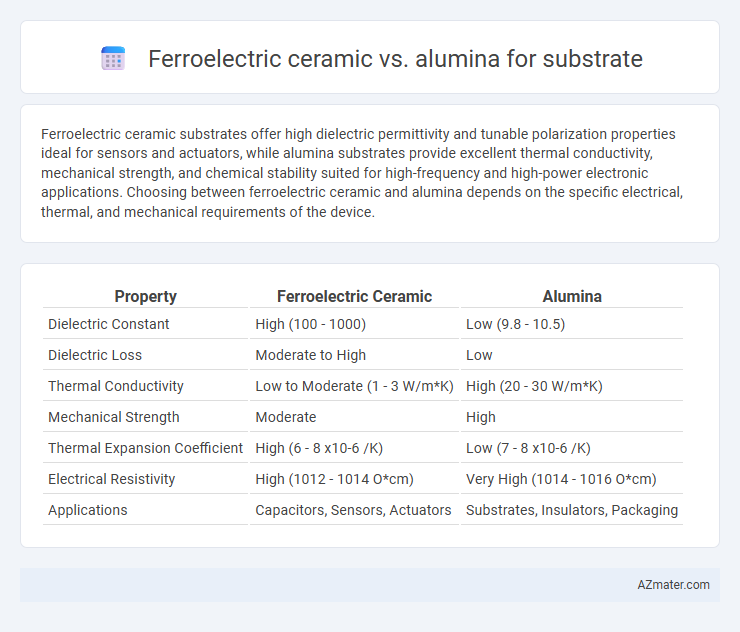Ferroelectric ceramic substrates offer high dielectric permittivity and tunable polarization properties ideal for sensors and actuators, while alumina substrates provide excellent thermal conductivity, mechanical strength, and chemical stability suited for high-frequency and high-power electronic applications. Choosing between ferroelectric ceramic and alumina depends on the specific electrical, thermal, and mechanical requirements of the device.
Table of Comparison
| Property | Ferroelectric Ceramic | Alumina |
|---|---|---|
| Dielectric Constant | High (100 - 1000) | Low (9.8 - 10.5) |
| Dielectric Loss | Moderate to High | Low |
| Thermal Conductivity | Low to Moderate (1 - 3 W/m*K) | High (20 - 30 W/m*K) |
| Mechanical Strength | Moderate | High |
| Thermal Expansion Coefficient | High (6 - 8 x10-6 /K) | Low (7 - 8 x10-6 /K) |
| Electrical Resistivity | High (1012 - 1014 O*cm) | Very High (1014 - 1016 O*cm) |
| Applications | Capacitors, Sensors, Actuators | Substrates, Insulators, Packaging |
Introduction to Substrate Materials
Ferroelectric ceramics offer high dielectric constants and tunable permittivity, making them ideal for applications requiring adjustable electronic properties. Alumina substrates provide excellent thermal conductivity, mechanical strength, and chemical stability, commonly used in high-frequency and high-power devices. The choice between ferroelectric ceramic and alumina depends on the specific electrical performance and environmental requirements of the application.
Overview of Ferroelectric Ceramics
Ferroelectric ceramics, known for their spontaneous electric polarization that can be reversed by an external electric field, offer high dielectric constants and strong piezoelectric properties, making them ideal for sensors, actuators, and tunable capacitors. Unlike alumina substrates, ferroelectric ceramics exhibit nonlinear dielectric behavior and enhanced electromechanical coupling, which are critical for applications requiring dynamic response and frequency agility. Their complex crystal structures and ferroelectric domains provide superior tunability and sensitivity compared to alumina's stable, inert ceramic matrix primarily used for mechanical support and insulation.
Properties of Alumina Substrates
Alumina substrates are widely used in electronic applications due to their excellent thermal conductivity, high electrical insulation, and mechanical strength, which provide stable performance under high-temperature conditions. Their low dielectric loss and dielectric constant ensure efficient signal transmission, making them ideal for high-frequency circuits. Compared to ferroelectric ceramics, alumina substrates offer superior chemical stability and cost-effectiveness, although they lack the tunable dielectric properties found in ferroelectric materials.
Dielectric Performance Comparison
Ferroelectric ceramic substrates exhibit high dielectric constants typically ranging from 100 to 10,000, enabling superior capacitive properties compared to alumina, which has a relatively low dielectric constant around 9.8 to 10. Alumina offers excellent dielectric strength and low dielectric loss at high frequencies, making it suitable for stable signal transmission, while ferroelectric ceramics demonstrate tunable permittivity advantageous in adaptive applications but suffer from higher dielectric losses. The choice between ferroelectric ceramics and alumina for substrates depends on the trade-off between high permittivity and low loss requirements in RF and microwave circuit designs.
Thermal Conductivity and Management
Ferroelectric ceramic substrates typically exhibit lower thermal conductivity, around 2 to 5 W/m*K, compared to alumina's higher thermal conductivity of approximately 20 to 30 W/m*K, enabling better heat dissipation in high-power applications. Alumina substrates provide more efficient thermal management, reducing thermal stress and enhancing device reliability during operation. The choice between ferroelectric ceramic and alumina substrates depends heavily on the specific thermal requirements and performance targets of the electronic device.
Mechanical Strength and Reliability
Ferroelectric ceramics exhibit higher mechanical strength compared to alumina substrates due to their intrinsic crystal lattice structure, making them more resistant to cracking under stress. Alumina, while offering excellent thermal stability and electrical insulation, generally has lower fracture toughness, which can compromise reliability in high-impact or flexural applications. The superior mechanical robustness of ferroelectric ceramics enhances device longevity and performance stability in environments subject to mechanical strain.
Application Suitability: Ferroelectric vs Alumina
Ferroelectric ceramics exhibit high dielectric constants and tunable permittivity, making them ideal for applications requiring precise electric field control, such as capacitors, sensors, and actuators in advanced electronics. Alumina substrates offer excellent thermal conductivity, mechanical strength, and chemical stability, suited for high-frequency and high-power microwave devices, as well as insulating layers in electronic packaging. The selection between ferroelectric ceramic and alumina substrates hinges on the specific demands of dielectric tunability versus thermal and mechanical robustness in targeted electronic applications.
Fabrication Processes and Cost Considerations
Ferroelectric ceramics require precise control during sintering and poling processes, leading to higher fabrication complexity and cost compared to alumina substrates, which benefit from well-established, cost-effective manufacturing methods such as tape casting and high-temperature firing. Alumina's mechanical robustness and lower dielectric loss make it a preferred choice for mass production despite ferroelectric ceramics offering superior electro-mechanical properties for specialized applications. The cost-performance trade-off favors alumina for standard electronic substrates, while ferroelectric ceramics are reserved for advanced devices requiring tunable dielectric characteristics.
Integration with Electronic Devices
Ferroelectric ceramic substrates offer superior dielectric properties and tunable permittivity, enabling enhanced signal modulation and miniaturization of electronic devices. Alumina substrates provide excellent thermal conductivity and mechanical stability but lack the intrinsic ferroelectric behavior needed for advanced tunable components. Integration with ferroelectric ceramics supports dynamic device functionality in RF and microwave applications, while alumina remains preferred for high-power and high-frequency stability.
Future Trends in Substrate Material Selection
Ferroelectric ceramics offer superior tunability and dielectric properties compared to alumina, driving innovation in high-frequency and tunable microwave devices. Emerging trends emphasize integrating ferroelectric materials with advanced manufacturing techniques to enhance performance and miniaturization, whereas alumina remains favored for its mechanical stability and cost-effectiveness in mainstream applications. Future substrate material selection increasingly prioritizes multifunctionality and compatibility with next-generation electronics, pushing research towards hybrid composites and novel ferroelectric formulations.

Infographic: Ferroelectric ceramic vs Alumina for Substrate
 azmater.com
azmater.com